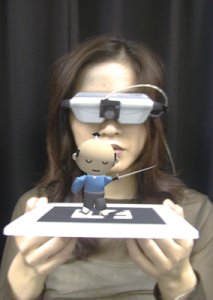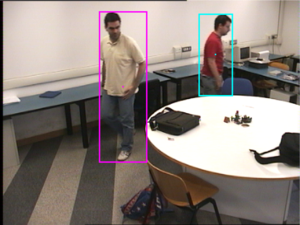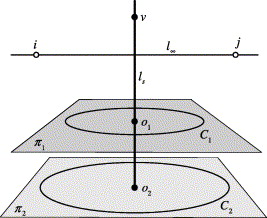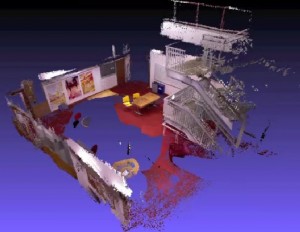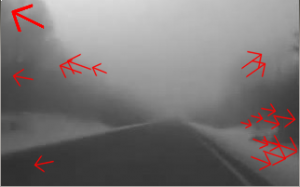|
|
| Line 1: |
Line 1: |
| | + | Computer Vision research involves both feature extraction from two-dimensional images, and analysis and reconstruction of 3D scenes. |
| | + | |
| | + | == Ongoing Projects == |
| | + | {{#ask: [[Category:Project]][[prjResArea::{{PAGENAME}}]][[PrjEnd::>{{CURRENTYEAR}}/{{CURRENTMONTH}}/{{CURRENTDAY}}]]|?prjTitle = |format=ul}} |
| | + | |
| | + | == Project Proposals == |
| | + | {{#ask: [[Category:ProjectProposal]] |
| | + | [[PrjResArea::{{PAGENAME}}]]| |
| | + | ?PrjTitle | |
| | + | ?PrjImage | |
| | + | ?PrjDescription | |
| | + | ?PrjTutor | |
| | + | ?PrjStarts | |
| | + | ?PrjStudMin | |
| | + | ?PrjStudMax | |
| | + | ?PrjCFUMin | |
| | + | ?PrjCFUMax | |
| | + | ?PrjResArea | |
| | + | ?PrjResTopic | |
| | + | ?PrjLevel | |
| | + | ?PrjType | |
| | + | format = template | |
| | + | template = Template:ProjectProposalVizSlim |
| | + | }} |
| | + | |
| | + | == People == |
| | + | |
| | + | {{#ask: [[HasResArea::{{PAGENAME}}]] | format=ul}} |
| | + | |
| | + | |
| | + | ==Past Projects== |
| | + | |
| | + | {{#ask: [[Category:Project]][[prjResTopic::{{PAGENAME}}]][[PrjEnd::<{{CURRENTYEAR}}/{{CURRENTMONTH}}/{{CURRENTDAY}}]] |format=ul}} |
| | + | |
| | + | |
| | ==Hardware== | | ==Hardware== |
| | If you are looking for a list of the computer vision gear that you can find in the AIRLab, please look here: [[Cameras, lenses and mirrors]]. If you want a list of ''all'' the gear that you can find in the AIRLab, [[What's in the AIRLab]] is the right page. | | If you are looking for a list of the computer vision gear that you can find in the AIRLab, please look here: [[Cameras, lenses and mirrors]]. If you want a list of ''all'' the gear that you can find in the AIRLab, [[What's in the AIRLab]] is the right page. |
Revision as of 17:39, 21 December 2009
Computer Vision research involves both feature extraction from two-dimensional images, and analysis and reconstruction of 3D scenes.
Ongoing Projects
Project Proposals
Wiki Page: Accurate AR Marker Location
Title: C++ Library for accurate marker location based on subsequent pnp refinements
Description: ARTags, QR codes, Data Matrix, are visual landmark used for augmented reality, but they could be used for robotics as well. A thesis has already been done on using data matrix for robot localization and mapping, but improvements are required in terms generality, accuracy and robustness of the solution. The goal is thuss to:
- increase the number of markers supported by the system (ARTag + QR codes)
- increase the accuracy of the detection and localization of the marker
- test different algorithms for the solution of the perspective from n points problem
Material:
- papers on PnP algorithms, OpenCV,
- Matlab code with three PnP algorithms implementations
- C++ libraries for marker detection (to be found and evaluated)
Expected outcome:
- C++ library to the robust localization of artificial markers
- a ROS node performing accurate ARTag localization
- a comparison of Tags and algorithms in a real world scenario
- The use of this library in a SLAM framework (Thesis)
Required skills or skills to be acquired:
- background on computer vision and image processing
- C++ programming under Linux
Tutor: MatteoMatteucci
Additional Info: CFU 5 - 10 / Bachelor of Science, Master of Science / Thesis, Course
|
Wiki Page: Comparison of State of the Art Visual Odometry Systems
Title: A Comparison of State of the Art Visual Odometry Systems (Monocular and Stereo)
Description: Visual odometry is the estimation of camera(s) movement from a sequence of images. In case we deal with a single camera system we have Monocular Visual Odometry; in case we have more cameras we have a Stero Visual Odometry. The goal of the thesis is to review the state of the art on in visual odometry, classify existing approaches and compare their implementations (many of the algorithms have online source code available).
Material
Expected outcome:
- a set of running algorithms performing visual odometry
Required skills or skills to be acquired:
- computer vision and 3D reconstruction
- C++ programming under Linux
Tutor: MatteoMatteucci
Additional Info: CFU 10 - 20 / Bachelor of Science, Master of Science / Thesis, Course
|
Wiki Page: Environment Monitoring
Title: Environment Monitoring
Description: The goal of this project is to develop a video surveillance system to track in 3D vehicles or people.
The idea is to use one or more calibrated camera to estimate the position and the trajectories of the moving objects in the scene.
The skills required for this project are:
- C/C++ and OpenCV library
- Linux o.s.
- Geometry/Image processing
- Probabilistic robotics/IMAD
Tutor: MatteoMatteucci, DavideMigliore
Additional Info: CFU 10 - 15 / Course
|
Wiki Page: Odometric system based on circular points
Title: An odometric sensor based on circular points
Description: Development of an odometric sensor based on an uncalibrated camera pointing the floor based on circular points. The system should extend an existing prototype introducing a robust mechanism for tracking of feature points, and by integrating possibly available information about the robot motion.
Material:
- existing prototypical implementation of the system
Expected outcome:
- an odometric sensor for planar odometry with uncalibrated camera
Required skills or skills to be acquired:
- Good mathematical background
- Backgroundd in computer vision
- C++ programming under Linux
Tutor: VincenzoCaglioti
Additional Info: CFU 10 - 20 / Bachelor of Science, Master of Science / Thesis
|
Wiki Page: Poit cloud SLAM with Microsoft Kinect
Title: Point cloud SLAM with Microsoft Kinect
Description: Simultaneous Localization and Mapping (SLAM) is one of the basic functionalities required from an autonomous robot. In the past we have developed a framework for building SLAM algorithm based on the use of the Extended Kalman Filter and vision sensors. A recently available vision sensor which has tremendous potential for autonomous robots is the Microsoft Kinect RGB-D sensor. The thesis aims at the integration of the Kinect sensor in the framework developed for the development of a point cloud base system for SLAM.
Material:
- Kinect sensor and libraries
- A framework for multisensor SLAM
- PCL2.0 library for dealing with point clouds
Expected outcome:
- Algorithm able to build 3D point cloud representation of the observed scene
- Point clouds processing could be used to improve the accuracy of the filter as well
Required skills or skills to be acquired:
- Basic background in computer vision
- Basic background in Kalman filtering
- C++ programming under Linux
Tutor: MatteoMatteucci
Additional Info: CFU 10 - 20 / Master of Science / Thesis
|
Wiki Page: Visual Odometry for an Omni-directional Camera
Title: Visual Odometry for an Omni-directional Camera
Description: An omnidirectional camera can acquire panoramic views of the surrounding environment. The purpose of this thesis is to design, develop, and test an odometric system (odometry = measurement of the path) based on the images taken by an omnidirectional camera during motion. The reference paper to start from is (Taddei, Ferran, Caglioti. IJCV 2012) and the result should be able to extract “feature points” from the images, match them in a robust way, and then apply the machinery for visual odometry on the resulting set of correspondences. A calibration procedure for the system should be provided together with an experimental validatio of the resulting system.
- Pierluigi Taddei, Ferran Espuny, Vincenzo Caglioti: Planar Motion Estimation and Linear Ground Plane Rectification using an Uncalibrated Generic Camera. International Journal of Computer Vision 96(2): 162-174 (2012)
Material:
- reference paper to start from and reference datasets
- C++ library for extraction and manipulation of features (OpenCV)
Expected outcome:
- working system able to perform visual odometry using an omnidirectional camera
Required skills or skills to be acquired:
- computer vision and 3D reconstruction
Tutor: VincenzoCaglioti
Additional Info: CFU 10 - 20 / Bachelor of Science, Master of Science / Thesis
|
Wiki Page: Visual stabilization techniques for tracking with a moving camera
Title: Visual stabilization techniques for tracking with a moving camera
Description: Target tracking in video sequences can suffer poor performances if the camera is moving (e.g, wind, hand held device, aerial tracking system). The aim of the project is to investigate the state of the art in image stabilization and registration in non static or cluttered scenes. Possible ideas to be investigated include: homography tracking or smoothing, 3D camera motion estimation, image registration and mosicing. As a by product of the work, a tool for the performance evaluation of image stabilization algorithms should be designed.
Material
- a huge corpus of literature on the topic
- datasets to test the approach upon
- C++ library for image processing and computer vision (OpenCV)
Expected outcome:
- software for the stabilization of videos from a moving camera showing moving objects in cluttered environments
- a tool for the objective evaluation of image stabilization algorithms
Required skills or skills to be acquired:
- computer vision and 3D reconstruction
- C++ programming under Linux
Tutor: MatteoMatteucci
Additional Info: CFU 10 - 20 / Bachelor of Science, Master of Science / Thesis
|
People
Past Projects
Hardware
If you are looking for a list of the computer vision gear that you can find in the AIRLab, please look here: Cameras, lenses and mirrors. If you want a list of all the gear that you can find in the AIRLab, What's in the AIRLab is the right page.
